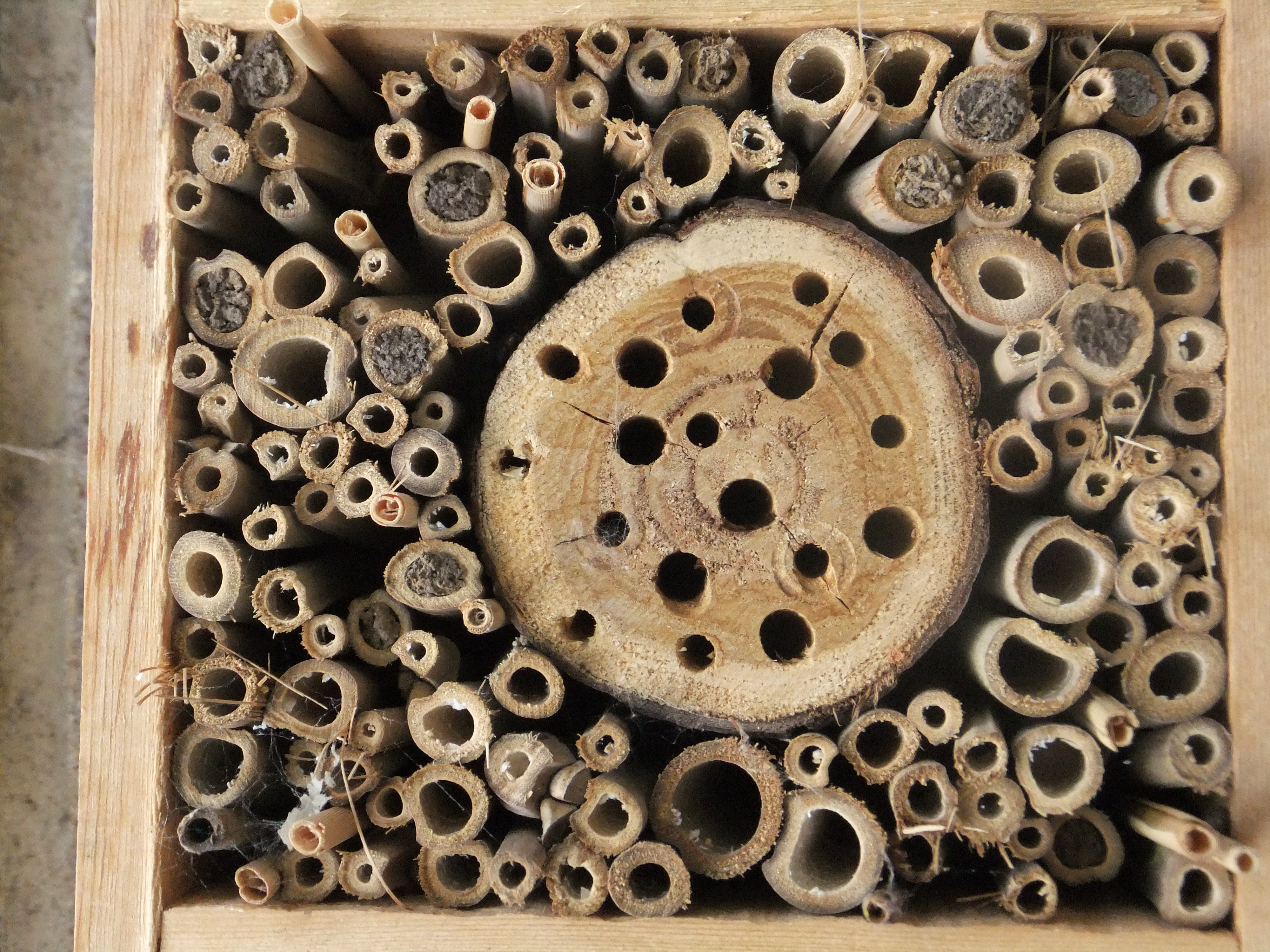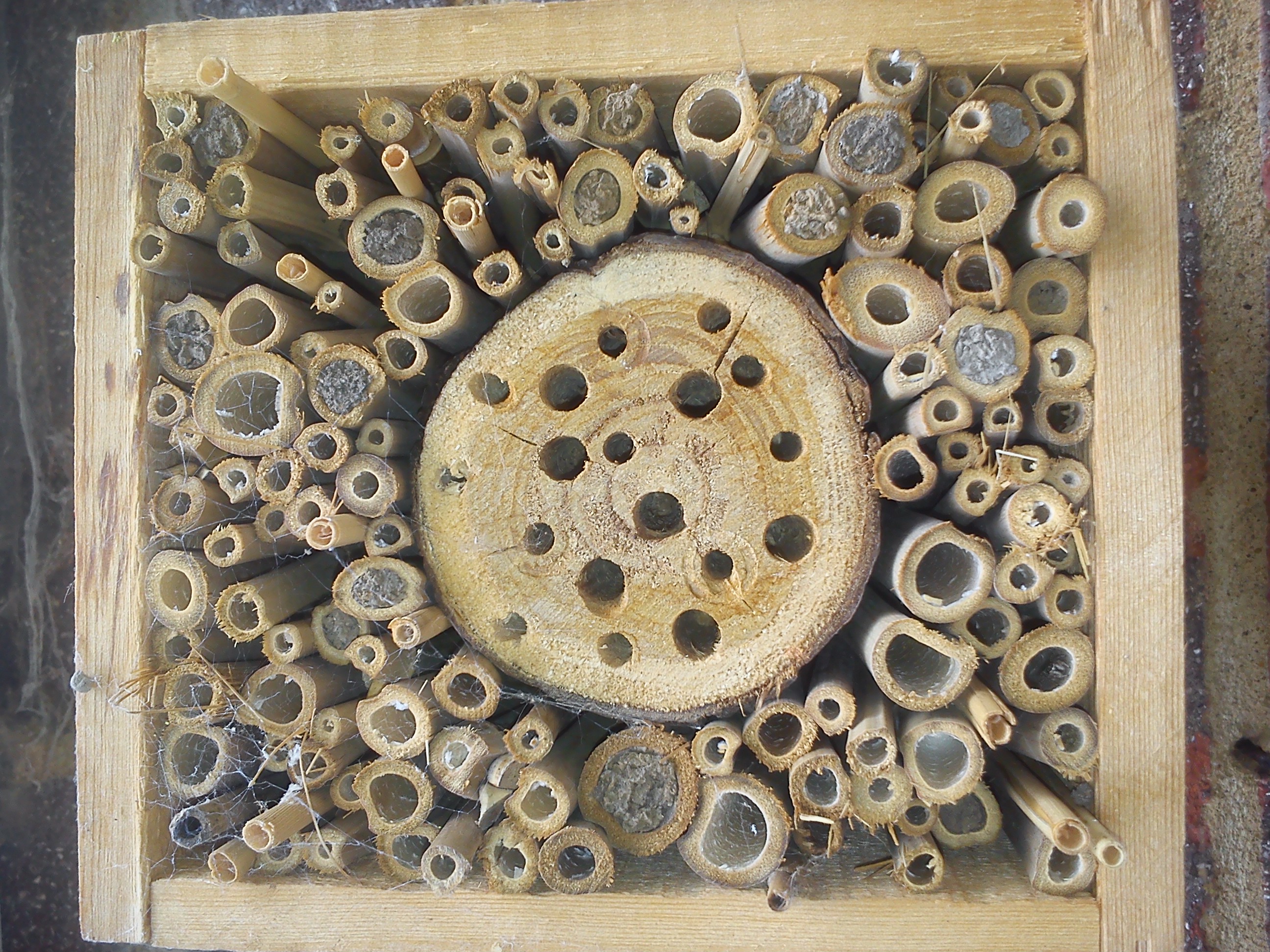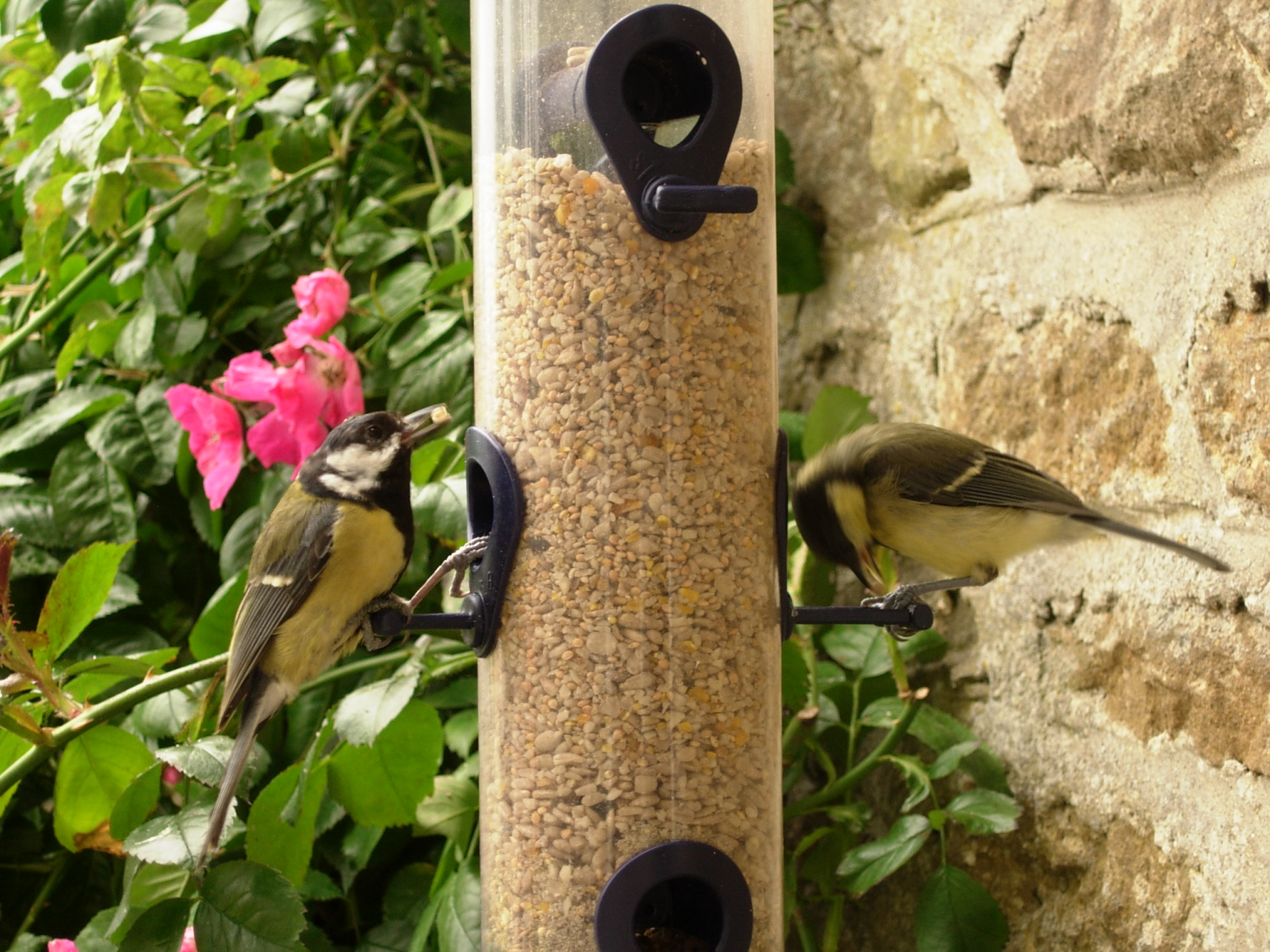Wildlife Gardening products that do and don’t work
For a much more complete account read our leaflet here
Garden Centres are now devoting substantial areas of their stores to various wildlife gardening products. While bird food, bird feeders and bird boxes dominate - and the bird feeding industry is thought to be worth £200 million per year - you can buy boxes for bats, hedgehogs, bumblebees, solitary bees - and much more. Are all these products useful for the wildlife in your garden, or could you be wasting your money?
Nest boxes
Lots of studies have shown that songbirds use nesting boxes, and they can help increase their numbers and/or breeding success. It is best if the boxes are faced between north and east, and there is good evidence that boxes made of woodcrete, which is a mix of concrete and sawdust, are preferred by many species, perhaps because they are better insulated than plain wood. Rather surprisingly, there is little evidence that cleaning out nest boxes annually is necessary, but it is probably worth doing so every two or three years.
Typical commercial bird feeder filled with seeds. Good practice would suggest putting much less seed in the feeder so that it does not go stale or get wet, and to shorten the time before it is taken down and cleaned before refilling.
Cat deterrents
You can buy ultrasonic devices to keep cats out of your garden, but there is little evidence that they work. Similarly, fitting deterrents onto the cat’s collar seems no more effective than the old fashioned bell, not that bells are very effective either. One product that does appear to work is the CatBib™ ‘pounce protector’, a neoprene flap hanging from a collar, which warns birds and interferes with pouncing. The cat loses some dignity, but the device reduces bird catching by 81%, and seems safe, and not to cause distress.
Bat boxes
Evidence suggests that bats prefer dark coloured boxes made of woodcrete, because they are warmer, but occupancy rates are not great, since bats may use different boxes on different occasions and for different purposes. It is worth persisting though, because older boxes are more likely to be used.
Bumblebee boxes
UK trials of bumblebee boxes have consistently failed to demonstrate extensive use, or indeed any at all. Buried boxes, with a long entrance pipe seem to work better than the normal surface boxes offered for sale. You can even buy boxes with colonies of bumblebees already installed, but there seems little point since bumblebees are common in gardens, and gardens often contain wild nests as well. There is also a danger that these often imported colonies could bring in diseases.
Solitary bee nests
These fascinating insects make simple nests in hollow stems, or holes in wood or stonework, or even excavate nests in soil. Many sorts of artificial nest are available for a price, and they have been shown to increase bee numbers locally. You can however make just as good a product yourself, by tying bundles of short sections of bamboo cane together (each blind at one end and open at the other), or by drilling 4 and 6 mm holes into blocks of wood. You can find excellent guidance on making your own bee boxes at Marc Carlton's website here.

Wildlife gardening products should work!
Consumers expect the products they buy to work, and will be disappointed if the bug box they buy and set up proves not to attract what they were hoping for. This disappointment could very easily turn to a rejection of the whole concept of wildlife gardening as a waste of time. This could be particularly unfortunate if the item concerned was bought for a child. We need more research on wildlife products, but sufficient studies have been made for us to know that while some products are excellent, many are not. For the full story on garden wildlife products, download the article we have prepared. What follows below is a brief summary.
Bird feeders.
These undoubtedly work, in that if you put them in your garden (and keep them filled up) birds will use them, and you will be able to watch them. Some birds, such as greenfinches prefer the feeders as far from the house as possible, sparrows like them near the house, or by a hedge, giving them cover. Some species prefer maize or cereal seeds, while finches like oily seeds such as sunflowers. Birds feed more from feeders in winter, when high calorie foods like fat balls are most appreciated. It is important to keep feeders clean and properly sterilised, or instead of helping your birds, they may be passing on some unpleasant diseases which have appeared recently.
Wildlife Gardening is big business!
But do you get your money's worth?
A bee box at the Natural History Museum wildlife garden Left: May 2014, Right: June 2014 with more holes occupied
Other boxes
If you wish you can invest in boxes sold to encourage ladybirds, lacewings, butterflies, hedgehogs and dormice. Dormice boxes only work in the very unlikely situation that your garden is next to a nature reserve with a viable colony of dormice. There is little or no evidence that the other boxes work, or that the average garden doesn’t already provide plenty of shelter, especially if you have creeper like ivy on the wall of the house.
For a much more complete account read our leaflet here.
Download our practical guides:
How to: Feed garden birds
How to: Make & maintain a bird box
How to: Create and maintain bee hotels
Page written by Ken Thompson Reviewed and compiled by Steve Head
Wildlife Gardening products that do and don’t work
Garden Centres are now devoting substantial areas of their stores to various wildlife gardening products. While bird food, bird feeders and bird boxes dominate - and the bird feeding industry is thought to be worth £200 million per year - you can buy boxes for bats, hedgehogs, bumblebees, solitary bees - and much more. Are all these products useful for the wildlife in your garden, or could you be wasting your money?

Wildlife Gardening is big business!
But do you get your money's worth?
Wildlife gardening products should work!
Consumers expect the products they buy to work, and will be disappointed if the bug box they buy and set up proves not to attract what they were hoping for. This disappointment could very easily turn to a rejection of the whole concept of wildlife gardening as a waste of time. This could be particularly unfortunate if the item concerned was bought for a child. We need more research on wildlife products, but sufficient studies have been made for us to know that while some products are excellent, many are not. For the full story on garden wildlife products, download the article we have prepared. What follows below is a brief summary.
Bird feeders.
These undoubtedly work, in that if you put them in your garden (and keep them filled up) birds will use them, and you will be able to watch them. Some birds, such as greenfinches prefer the feeders as far from the house as possible, sparrows like them near the house, or by a hedge, giving them cover. Some species prefer maize or cereal seeds, while finches like oily seeds such as sunflowers. Birds feed more from feeders in winter, when high calorie foods like fat balls are most appreciated. It is important to keep feeders clean and properly sterilised, or instead of helping your birds, they may be passing on some unpleasant diseases which have appeared recently.
Typical commercial bird feeder filled with seeds. Good practice would suggest putting much less seed in the feeder so that it does not go stale or get wet, and to shorten the time before it is taken down and cleaned before refilling.
Nest boxes
Lots of studies have shown that songbirds use nesting boxes, and they can help increase their numbers and/or breeding success. It is best if the boxes are faced between north and east, and there is good evidence that boxes made of woodcrete, which is a mix of concrete and sawdust, are preferred by many species, perhaps because they are better insulated than plain wood. Rather surprisingly, there is little evidence that cleaning out nest boxes annually is necessary, but it is probably worth doing so every two or three years.
Cat deterrents
You can buy ultrasonic devices to keep cats out of your garden, but there is little evidence that they work. Similarly, fitting deterrents onto the cat’s collar seems no more effective than the old fashioned bell, not that bells are very effective either. One product that does appear to work is the CatBib™ ‘pounce protector’, a neoprene flap hanging from a collar, which warns birds and interferes with pouncing. The cat loses some dignity, but the device reduces bird catching by 81%, and seems safe, and not to cause distress.
Bat boxes
Evidence suggests that bats prefer dark coloured boxes made of woodcrete, because they are warmer, but occupancy rates are not great, since bats may use different boxes on different occasions and for different purposes. It is worth persisting though, because older boxes are more likely to be used.
Bumblebee boxes
UK trials of bumblebee boxes have consistently failed to demonstrate extensive use, or indeed any at all. Buried boxes, with a long entrance pipe seem to work better than the normal surface boxes offered for sale. You can even buy boxes with colonies of bumblebees already installed, but there seems little point since bumblebees are common in gardens, and gardens often contain wild nests as well. There is also a danger that these often imported colonies could bring in diseases.
Solitary bee nests
These fascinating insects make simple nests in hollow stems, or holes in wood or stonework, or even excavate nests in soil. Many sorts of artificial nest are available for a price, and they have been shown to increase bee numbers locally. You can however make just as good a product yourself, by tying bundles of short sections of bamboo cane together (each blind at one end and open at the other), or by drilling 4 and 6 mm holes into blocks of wood. You can find excellent guidance on making your own bee boxes at Marc Carlton's website here.
A bee box at the Natural History Museum Wildlife Garden Left: May 2014, Right: June 2014 with more holes occupied
Other boxes
If you wish you can invest in boxes sold to encourage ladybirds, lacewings, butterflies, hedgehogs and dormice. Dormice boxes only work in the very unlikely situation that your garden is next to a nature reserve with a viable colony of dormice. There is little or no evidence that the other boxes work, or that the average garden doesn’t already provide plenty of shelter, especially if you have creeper like ivy on the wall of the house.
Download our practical guides:
How to: Feed garden birds
How to: Make & maintain a bird box
How to: Create and maintain bee hotels
Page written by Ken Thompson Reviewed and compiled by Steve Head




Typical bird nesting box with a nuthatch
![Photo: Gavin Hill, 24 May 2008 Derivative: Snowmanradio, 6 April 2014 [CC BY-SA (https://creativecommons.org/licenses/by-sa/2.0)]](images/Nuthatch.jpg)
Typical bird nesting box with a nuthatch
Typical bird nesting box with a nuthatch













